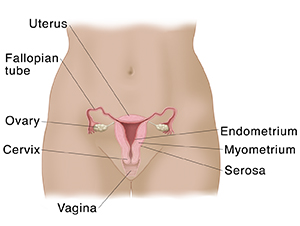Endometrial Cancer: Introduction
What is cancer?
Cancer is when cells in the body change and grow out of control. To help you understand what happens when you have cancer, let’s look at how your body works normally. Your body is made up of tiny building blocks called cells. Normal cells grow when your body needs them, and they die when your body does not need them any longer.
Cancer is made up of abnormal cells that grow even though your body doesn’t need them. In most cancers, the abnormal cells grow to form a lump or mass called a tumor. If cancer cells are in the body long enough, they can grow into (invade) nearby areas. They can also break off and spread to other parts of the body (metastasis).
What is endometrial cancer?
Endometrial cancer starts in the cells that form the inner lining of the uterus (which is called the endometrium).
You may hear endometrial cancer called uterine cancer. It's actually one of two main types of uterine cancer. The other is called uterine sarcoma. It starts in the muscle layer of the uterus, not the lining.
Endometrial cancer is the most common type of cancer in the uterus. It usually takes years to develop. It most often occurs in women who have already gone through menopause. It is highly curable when found early.
Understanding the uterus
The uterus is an organ. It’s part of the female reproductive system. You may know it as the womb. The uterus is usually pear-shaped and about the size of a fist. It is located in the lower belly (pelvic area) between your bladder and your rectum. Your uterus is connected to your fallopian tubes. These tubes help carry eggs from your ovaries into the uterus. The small opening that connects the uterus to your vagina is the cervix.
The uterus is made up of three layers:
-
Endometrium. This is the inner lining.
-
Myometrium. This is the middle muscle layer.
-
Serosa. This is the outer smooth layer.
The uterus protects a growing baby during pregnancy. During labor, the myometrium muscle tissue helps push the baby out through the cervix. The smooth serosa makes it easy for the uterus to move in the pelvis as needed.

Understanding the endometrium
In women who still have their periods, one of the ovaries releases an egg into a fallopian tube each month. During this time, the endometrium becomes thicker as it gets ready to receive a fertilized egg. If the egg connects with a male sperm cell, this fertilized egg attaches to the endometrium. If the egg is not fertilized, it travels out of the uterus along with the endometrial lining as a woman's period (menstrual flow).
How endometrial cancer spreads
If endometrial cancer spreads, it tends to grow into the muscle layer of the uterus, the myometrium, and then may go to places near the uterus. This may be the fallopian tubes, ovaries, cervix, vagina, or lymph nodes. It can also spread to the bladder or rectum. Advanced stages of endometrial cancer can spread as far as the bones and lungs. Most cases of endometrial cancer are found in the early stages before they have spread outside the uterus.
Cancer that spreads to other parts of the body is called metastatic cancer. The process is called metastasis. Metastasis is a complex process. The cancer cells of the tumor grow into other tissues, blood vessels, and the lymph system. They then travel through the bloodstream or lymph system to reach other parts of the body where they grow into new tumors.
Talk with your healthcare provider
If you have questions about endometrial cancer, talk with your healthcare provider. Your healthcare provider can help you understand more about this cancer.